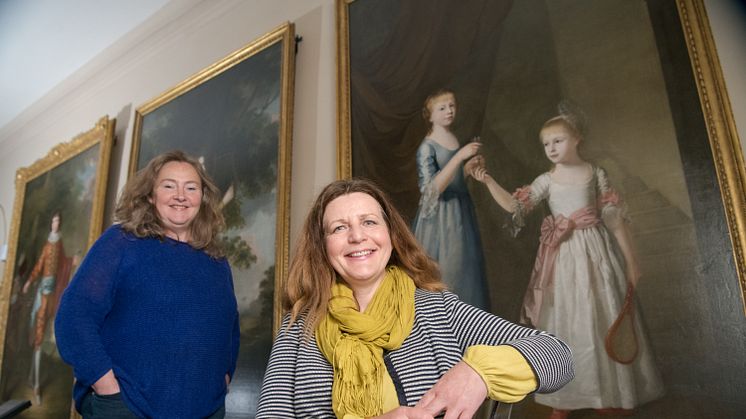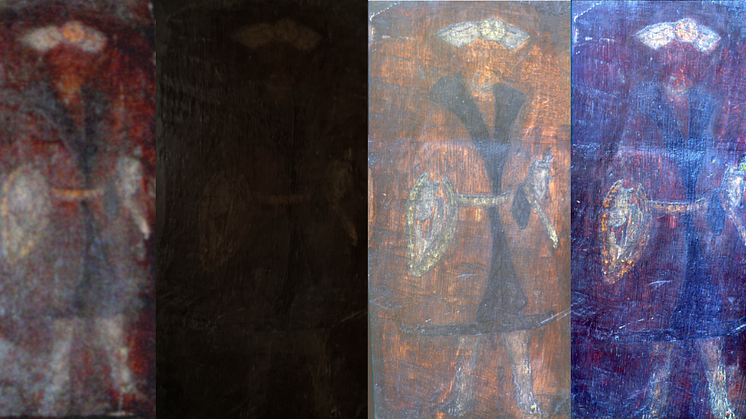
Press release -
Surprising secrets of Delaval sisters’ portrait revealed
A painting of two daughters from one of the North East’s most well-known families has been brought back to life – with some surprising discoveries made in the process by art conservation experts from Northumbria University.
The portrait of sisters Frances and Sarah Delaval was painted by Newcastle-born artist William Bell in 1771 and is part of a series of six portraits of members of the Delaval family which hang in the Long Gallery at Seaton Delaval Hall.
The family home of the Delaval and then Astley families for over 250 years, the Hall is now owned by the National Trust, which has been undertaking extensive conservation of the property and gardens, including the many collection items.
Assistant Professor of Art Conservation Nicky Grimaldi and former Art Conservation Masters student Reuben Ruxton were asked to carry out a technical analysis of the portrait to find out more about its history.
Using infrared, ultraviolet and x-ray technology they were able to see beneath the painting’s surface to reveal the styles used by Bell – including the 18thcentury technique of ‘dead-colouring’ where washes of different colours were applied of varying thicknesses.
Their investigations revealed some interesting results – including evidence of previous damage and the appearance of two additional unwanted feet.
As Nicky Grimaldi explains: “When examining the painting the phenomenon known as pentimenti was revealed more clearly. Pentimenti describes when, unintentionally, the lower image becomes more visible, in other words an artist’s alteration.
“In this case the artist would not have intended extra feet to be seen, but as oil paint tends to become more transparent over time, alterations like this are revealed.
“As a result of the technical investigation and x-raying of the painting the National Trust were able to decide the best way to preserve the portrait, with the decision made to retouch the areas most effected to bring the painting back to its former glory.”
Another surprising find made by Nicky and Reuben was evidence of a small hole in the painting which had been repaired at some point in the past. The size of the hole has led to speculation that it could have been caused by a Champagne cork – a theory which would fit with the Delaval family’s notoriously colourful lifestyle.
The findings were captured by the BBC as part of the six-part documentary series Hidden Treasures of the National Trust, which follows conservators and other experts at work at National Trust properties across the UK, including Seaton Delaval Hall, Cragside and Cherryburn in the North East.
Jo Moody, Cultural Heritage Curator for National Trust in the North said: “It’s fantastic to showcase the care and attention that goes into the work of the teams here in the North East, and of course throughout the National Trust. To be able to shine a light on the intricate and often costly work that goes into conserving these special objects is amazing.”
Alistair Pegg, of BBC Arts, added: “Almost six million of us are members of the National Trust, but in this series we wanted to offer viewers a chance to discover something that visitors don’t normally see – the efforts behind the scenes to care for the wonderful gardens, the houses and their treasures, that together tell a story about us all.”
The portrait of Frances and Sarah is one of six painted by William Bell during the 1770s, all depicting members of the Delaval family. Born in 1735, Bell was one of the Royal Academy’s first students and was awarded the Gold Medal for history painting for his depiction of Venus soliciting Vulcan to forge the armour of Æneas.
However, he returned to Northumberland before he was able to really make a name for himself in London, spending the rest of his career as artist in residence at Seaton Delaval Hall, with the portraits he captured of the Delaval family still hanging in the Hall to this day.
The portrait renovation is the latest in a number of projects between Northumbria University and the National Trust at Seaton Delaval Hall.
In 2019 Nicky Grimaldi and a group of Northumbria students were involved in analysing an inscription discovered on the wall of the Hall’s old kitchen following the removal of several layers of paint.
It is thought the writing related to the British Army’s Cameronian Scottish Rifles regiment, which was stationed at Seaton Delaval Hall during the Second World War, with soldiers housed in the Hall’s kitchens.
Speaking about the partnership, and the opportunity it offers students, Nicky said: “Over the years I have had a close working relationship with the National Trust, from directly conserving and researching artworks, to supporting students to gain experience of examining and working with collections such as William Bell’s portraits.
“Students really benefit from being exposed to an incredible support network and expertise within the organisation, as well as observing for themselves the extensive management of collections. This is an opportunity for them to really understand the standards and knowledge expected of art conservators.”
This is not the first time Nicky Grimaldi has made a surprising discovery when examining works of art. In 2019 she worked with The Bowes Museum in County Durham to discover more about a painting with significant alterations entitled The Death of Lucretia, for the ‘Power and the Virtue’ exhibition which featured paintings from around the UK including the National Gallery London.
Believed to have originated from the studio of Guido Reni, or at least painted during the same period in the seventeenth century, investigations revealed the painting was significantly changed during a re-paint some 200 years later.
And later that year Nicky uncovered something of a Christmas miracle when she discovered a nativity scene hidden under a painting of beheading of Saint John the Baptist.
Find out more about studying Conservation of Fine Art at Northumbria University.
- Ends -
Photo captions:
Photo 1: Emma Thomas, General Manager of Seaton Delaval Hall (left); and Nicky Grimaldi, Assistant Professor of Art Conservation at Northumbria University.
Photo 2: Nicky Grimaldi, Assistant Professor of Art Conservation at Northumbria University (left); and Emma Thomas, General Manager of Seaton Delaval Hall.
Topics
Categories
UNIVERSITY OF THE YEAR 2022 (Times Higher Education Awards)
Northumbria is a research-intensive university that unlocks potential for all, changing lives regionally, nationally and internationally. Find out more about us at www.northumbria.ac.uk
--- Please contact media.communications@northumbria.ac.uk with any media enquiries or interview requests ---










